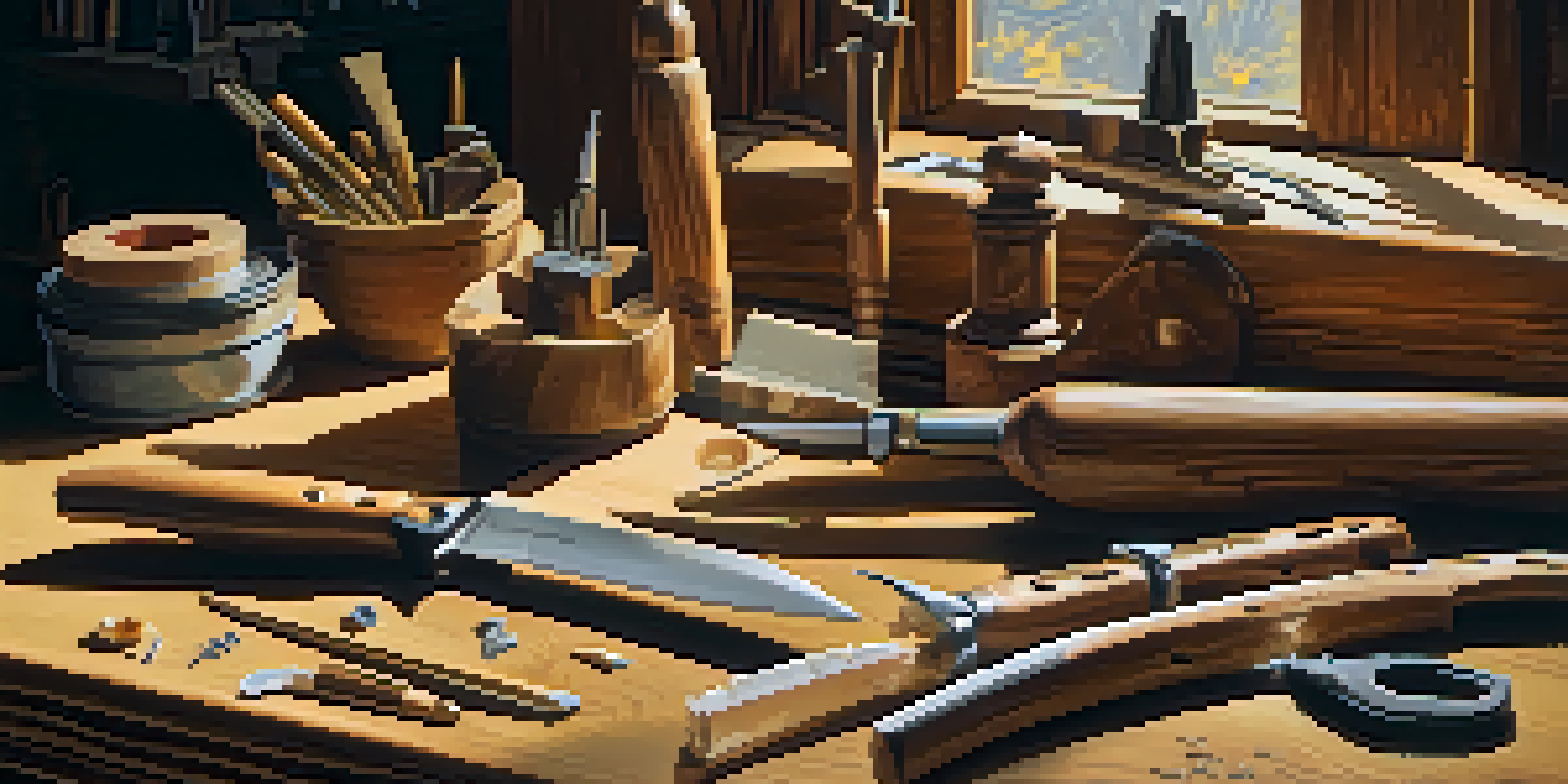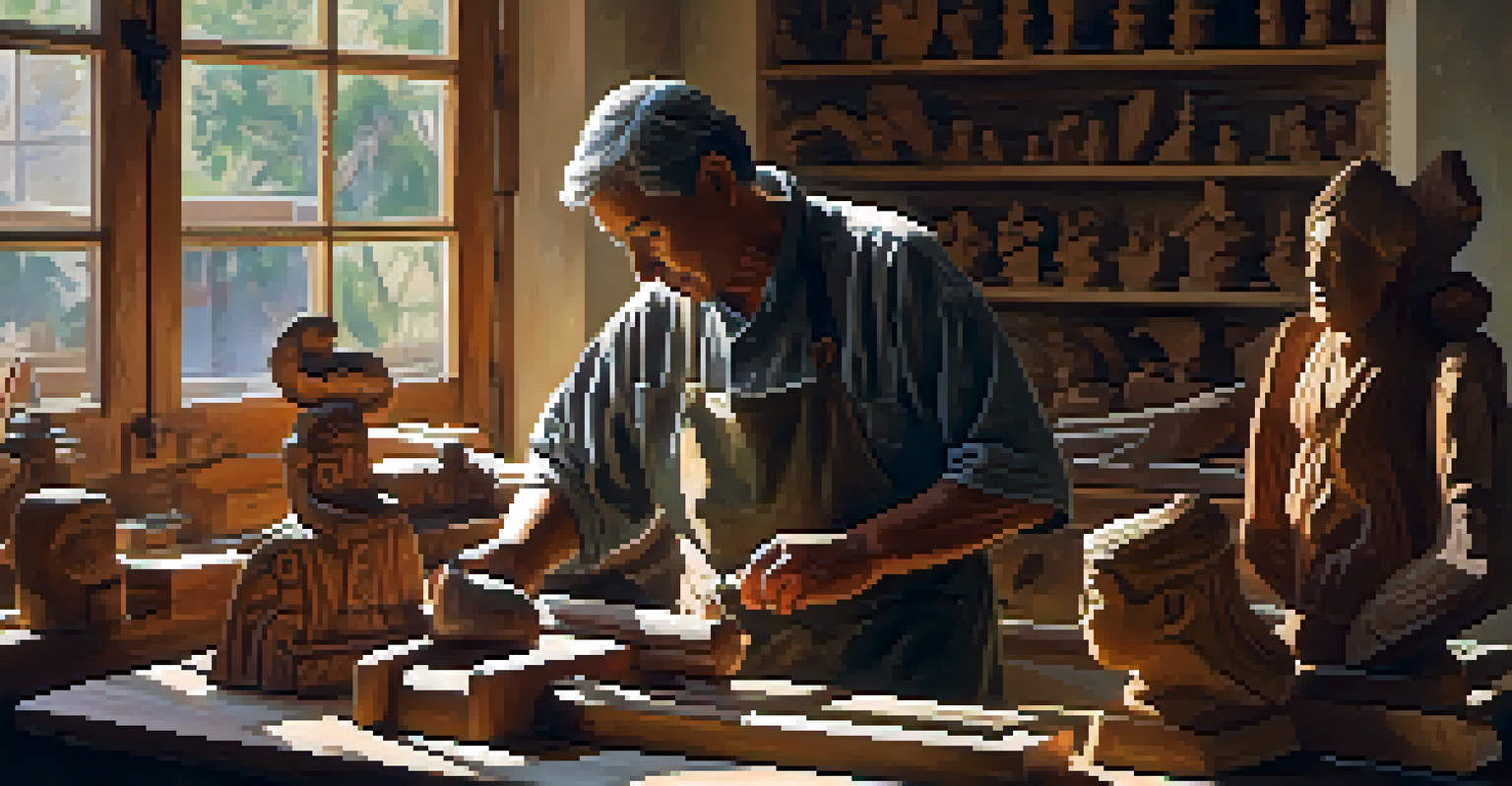Exploring the Art of Wood Carving for Home Decor Aesthetics

Understanding the Basics of Wood Carving
Wood carving is a form of artistry that involves shaping wood into decorative or functional objects. This craft can range from simple relief carvings to intricate sculptures, making it versatile for various home decor styles. Whether you’re a beginner or an experienced artisan, wood carving offers a satisfying way to express creativity and personalize your space.
Wood carving is a skill that takes time to develop, but the journey is as rewarding as the destination.
To start, you'll need some essential tools, such as carving knives, chisels, and safety gear. Choosing the right type of wood is equally important; softer woods like pine are great for beginners, while hardwoods like oak can provide a more polished look. Understanding these basics sets the foundation for creating beautiful pieces that can enhance your home’s aesthetic.
As you dive deeper into wood carving, you’ll discover various techniques, such as whittling, chip carving, and relief carving. Each method offers unique results, allowing you to experiment and find your personal style. This journey into wood carving not only improves your skills but also deepens your appreciation for the craftsmanship involved.
Choosing the Right Wood for Your Projects
Selecting the right wood is crucial for any carving project, as different types of wood can influence both the ease of carving and the final appearance. Softwoods, like pine or cedar, are often recommended for beginners due to their workability and affordability. On the other hand, hardwoods, such as mahogany or walnut, can provide stunning visual appeal and durability for more advanced projects.

Each wood type has its own characteristics; for example, oak is known for its strength and grain patterns, making it a favorite for furniture and decorative pieces. Consider the finish you want, as some woods absorb stains better than others. By knowing these traits, you can choose wood that aligns with your vision for the final product.
Essential Tools for Wood Carving
Having a well-rounded toolkit, including carving knives and chisels, is crucial for both beginners and experienced carvers to create with precision.
Additionally, it’s worth mentioning the environmental impact of your choices. Opting for sustainably sourced wood not only supports responsible forestry but also adds a story to your creations. This mindful approach to selecting materials can elevate your projects while contributing positively to the planet.
Basic Tools Every Wood Carver Should Have
To embark on your wood carving journey, you need the right set of tools that will help you create with precision and ease. Essential tools include carving knives, chisels, gouges, and a mallet for more intricate work. Having a well-rounded toolkit enables you to tackle various projects, from simple ornaments to detailed sculptures.
Every piece of wood tells a story; it is the carver's job to bring that story to life.
Investing in quality tools can make a significant difference in your carving experience. Good tools are not only more durable but also safer to use, reducing the risk of accidents. As you develop your skills, you may find yourself expanding your toolkit with specialized tools that suit your style and projects.
Don't forget the importance of maintaining your tools. Regular sharpening and proper storage will keep them in prime condition, ensuring they perform well for years to come. A well-cared-for tool is like a trusted friend, ready to help you bring your creative visions to life.
Techniques for Creating Stunning Wood Carvings
Once you have your tools and materials, it's time to explore various techniques that can elevate your wood carving skills. Techniques like whittling involve removing small shavings from the wood to shape your design gradually. This method is perfect for creating simple yet elegant pieces, such as figurines or decorative spoons.
Another popular technique is relief carving, where you carve into the surface to create a design that stands out. This approach can be used for wall art or decorative panels, allowing you to add depth and interest to flat surfaces. Experimenting with these techniques will help you understand the nuances of carving and develop your unique style.
Choosing the Right Wood Matters
Selecting the appropriate type of wood affects the ease of carving and the final appearance of your projects, making it a vital decision.
As you practice, don’t shy away from blending techniques or trying new ones. The beauty of wood carving lies in its versatility, and each technique can lead to unexpected and delightful results. Remember, the journey is just as important as the final piece, so enjoy the process and let your creativity flow.
Incorporating Wood Carvings into Home Decor
Wood carvings can be seamlessly integrated into your home decor, adding warmth and character to any space. From decorative bowls and wall art to furniture accents, the possibilities are endless. A beautifully carved piece can serve as a conversation starter and a focal point, drawing the eye and sparking interest.
Consider how your carved pieces can complement your existing decor style. For instance, rustic carvings work well in a farmhouse setting, while sleek, modern designs can enhance contemporary spaces. By thoughtfully placing your creations, you can create a harmonious environment that reflects your personality and taste.
Don't forget about the emotional aspect of wood carvings; each piece can carry a story or memory, making it more than just decor. Whether it's a gift from a loved one or a piece you crafted yourself, these items can evoke feelings and enhance the atmosphere of your home. This personal touch elevates your decor beyond aesthetics.
Caring for Your Wood Carving Creations
Caring for your wood carvings is essential to ensure they remain beautiful for years to come. Regular dusting with a soft cloth can help maintain their appearance, while occasional polishing with a suitable oil can enhance the wood's natural grain. Understanding the specific needs of the wood type used in your pieces is key to effective maintenance.
Avoid exposing your wood carvings to direct sunlight or excessive moisture, as these elements can cause warping or fading. A climate-controlled environment is ideal for preserving the integrity of your creations. By taking these precautions, you’ll ensure that your cherished pieces continue to bring joy and beauty to your home.
Cultural Importance of Wood Carving
Wood carving holds significant cultural value, with various traditions using it to express artistic identity and convey stories through their creations.
Additionally, if you ever notice any signs of damage, such as cracks or chips, address them promptly. Repairing minor issues can prevent larger problems down the line, allowing your carvings to remain in prime condition. Treating your wood carvings with care reflects the love and effort you put into creating them.
The Cultural Significance of Wood Carving
Wood carving is not just an art form; it's a practice steeped in cultural significance and history. Many cultures around the world have traditions of wood carving, using it to tell stories, celebrate heritage, and express artistic identity. Understanding these cultural backgrounds can enrich your appreciation for the craft and inspire your own work.
For instance, Native American tribes have a rich history of carving totem poles and ceremonial masks, each piece imbued with symbolism and meaning. Similarly, Scandinavian folk art features intricate carvings that celebrate nature and community. These traditions remind us that wood carving is a universal language, connecting us through creativity and shared experiences.

As you explore wood carving, consider how you can incorporate elements from different cultures into your work. This approach can lead to unique creations that honor tradition while infusing your personal touch. Embracing the cultural significance of wood carving not only enhances your artistry but also fosters a deeper connection to the global community of artists.